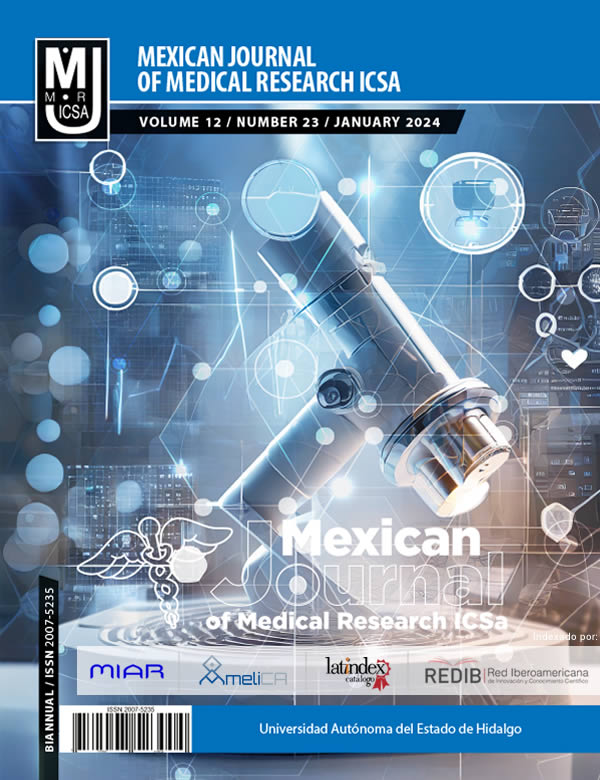Desarrollo de dislipidemias en una cohorte de pacientes adultos mexicanos con VIH/SIDA bajo terapia antirretroviral altamente activa
DOI:
https://doi.org/10.29057/mjmr.v12i23.11518Palabras clave:
Dislipidemias, terapia antirretroviral altamente activa, infecciones por VIH, síndrome de inmunodeficiencia adquiridaResumen
Las dislipidemias son comorbilidades en pacientes seropositivos bajo terapia antiretroviral altamente activa (TARAA), lo que incrementan su riesgo de complicaciones y reducen su esperanza de vida. Objetivo: evaluar la frecuencia y desarrollo de dislipidemias en pacientes seropositivos con TARAA. Material y método: estudio de cohorte retrospectivo, en pacientes VIH+ de reciente diagnóstico: 366 hombres y 59 mujeres. Se evaluaron concentraciones séricas de colesterol total (CT), triglicéridos (TGC), colesterol HDL (c-HDL) y colesterol LDL (c-LDL), antes de iniciar y al mes 6, 24, 36 y 48 con TARAA. Resultados: en ambos sexos al inicio de la TARAA se registró un 67,1% de niveles bajos de c-HDL. En todos los participantes las dislipidemias por TGC y CT aumentaron significativamente después de 48 meses de TARAA (36,9% vs. 52,7% y 7,1% vs. 22,4%, respectivamente, p<0,05), sin embargo, disminuyo la de c-HDL, en los pacientes con fármacos inhibidores de la transcriptasa reversa nucleósidos y no nucleósidos. Discusión: Los pacientes VIH+ con TARAA tienen un mayor riesgo de desarrollar dislipidemias, un aumento en las concentraciones se presentó desde los 6 meses de tratamiento, tendencia que continuó positiva hasta los 48 meses con TARAA. Conclusiones: las dislipidemias por TG y CT, así como c-HDL bajo son las más frecuentes en los pacientes VIH+, las cuales cambian dependiendo del tiempo y el tipo de fármaco indicado en la TARAA.
Descargas
Información de Publicación
Perfiles de revisores N/D
Declaraciones del autor
- Sociedad académica
- N/D
- Editora:
- Universidad Autónoma del Estado de Hidalgo
Citas
Hammer SM, Squires KE, Hughes MD, Grimes JM, Demeter LM, Currier JS, et al. A controlled trial of two nucleoside analogues plus indinavir in persons with human immunodeficiency virus infection and CD4 cell counts of 200 per cubic millimeter or less. AIDS Clinical Trials Group 320 Study Team. N. Engl. J .Med.
;337(11):725-33. DOI: 10.1056/NEJM199709113371101.
Ahmed D, Roy D, Cassol E. Examining relationships between metabolism and persistent inflammation in HIV patients on antiretroviral therapy. Mediators of inflammation. 2018;2018. DOI: 10.1155/2018/6238978.
Estrada V, Portilla J. Dyslipidemia related to antiretroviral therapy. AIDS Rev. 2011;13(1):49-56. PMID: 21412389
Chuapai Y, Kiertiburanakul S, Malathum K, Sungkanuparph S. Lipodystrophy and dyslipidaemia in human immunodeficiency virus-infected Thai patients receiving antiretroviral therapy. J. Med. Assoc. Thai. 2007;90(3):452-8. PMID: 17427520
Gilbert JM, Fitch KV, Grinspoon SK. HIV-Related Cardiovascular Disease, Statins, and the REPRIEVE Trial. Top. Antivir. Med. 2015;23(4):146-9. PMID: 26713505.
Estrada V, Domingo P, Suarez-Lozano I, Gutiérrez F, Knobel H, Palacios R, et al. Risk of cardiovascular disease in HIV-infected patients on antiretroviral therapy. Rev. Clin. Esp. 2020;220(3):149-54. DOI: 10.1016/j.rce.2019.05.006.
Group DS. Class of antiretroviral drugs and the risk of myocardial infarction. N. Engl. J .Med. 2007;356(17):1723-35. DOI:10.1056/NEJMoa062744
Health Protection. Reglamento de la ley general de salud en materia de investigación para la salud. 1987. DOF 02-04-2014.
Lipsy RJ. The National Cholesterol Education Program Adult Treatment Panel III guidelines. JMCP. 2003;9(1 Suppl):2-5. DOI: 10.18553/jmcp.2003.9.s1.2
World Health Organization. Obesity: preventing and managing the global epidemic: World Health Organization; 2000.
CENSIDA. Personas por estado, activas en sistema con Tratamiento Antirretroviral 2023. Accessed 13/03/2023, available at: https://datos.gob.mx/busca/dataset/personas-por-estado-activas-en-sistema-con- tratamiento-antirretroviral-2023
Beyrer C, Baral SD, Van Griensven F, Goodreau SM, Chariyalertsak S, Wirtz AL, et al. Global epidemiology of HIV infection in men who have sex with men. The Lancet. 2012;380(9839):367-77. DOI: 10.1016/S0140-6736(12)60821-6.
Shen Y, Wang J, Wang Z, Qi T, Song W, Tang Y, et al. Prevalence of dyslipidaemia among antiretroviral-naive HIV-infected individuals in China. Medicine. 2015;94(48). DOI: 10.1097/MD.0000000000002201.
Feingold KR, Grunfeld C. Effect of inflammation on HDL structure and function. Curr. Opin. Lipidol. 2016;27(5):521-30. DOI: 10.1097/MOL.0000000000000333.
. Mukhamedova N, Brichacek B, Darwish C, Popratiloff A, Sviridov D, Bukrinsky M. Analysis of ABCA1 and Cholesterol Efflux in HIV-Infected Cells. Methods. Mol. Biol. 2016;1354:281-92. DOI: 10.1007/978-1-4939-3046-3_19.
Tadewos A, Addis Z, Ambachew H, Banerjee S. Prevalence of dyslipidaemia among HIV-infected patients using first-line highly active antiretroviral therapy in Southern Ethiopia: a cross-sectional comparative group study. AIDS Res. Ther.. 2012;9(1):31. DOI: 10.1186/1742-6405-9-31.
Grunfeld C, Kotler DP, Shigenaga JK, Doerrler W, Tierney A, Wang J, et al. Circulating interferon-alpha levels and hypertriglyceridemia in the acquired immunodeficiency syndrome. Am. J. Med. 1991;90(2):154-62. PMID: 1996584.
Haugaard SB AO, Pedersen SB, Dela F, et al. Tumor necrosis factor alpha is associated with insulin-mediated suppression of free fatty acids and net lipid oxidation in HIV-infected patients with lipodystrophy. Metabolism. 2006:175-82. DOI: 10.1016/j.metabol.2005.08.018
De Pablo-Bernal RS, Ruiz-Mateos E, Rosado I, Dominguez-Molina B, Alvarez- Rios AI, Carrillo-Vico A, et al. TNF-alpha levels in HIV-infected patients after long- term suppressive cART persist as high as in elderly, HIV-uninfected subjects. J. Antimicrob. Chemother. 2014;69(11):3041-6. DOI: 10.1093/jac/dku263.
Karthikeyan N. Prevalence of Dyslipidemia among HIV Infected Patients using First Line HAART in Coimbatore Medical College Hospital: Coimbatore Medical Collegel, Coimbatore; 2015.
Zhou H-y, Zheng Y-h, He Y, Chen Z, Liu M, Yin W, et al. Evaluation of a 6- year highly active antiretroviral therapy in Chinese HIV-1-infected patients. Intervirology. 2010;53(4):240-6. DOI: 10.1159/000302762.
García-Benayas T, Blanco F, Alcolea A, Cruz JJDL, González-Lahoz J, Soriano V. Benefits in the lipid profile after substitution of abacavir for stavudine: a 48-week prospective study. AIDS Res. Hum. Retrovir. 2004;20(12):1289-92. DOI: 10.1089/aid.2004.20.1289.
Gwag T, Meng Z, Sui Y, Helsley RN, Park S-H, Wang S, et al. Non-nucleoside reverse transcriptase inhibitor efavirenz activates PXR to induce hypercholesterolemia and hepatic steatosis. J. Hepatol. 2019;70(5):930-40. DOI: 10.1016/j.jhep.2018.12.03






















